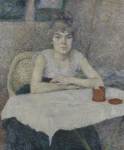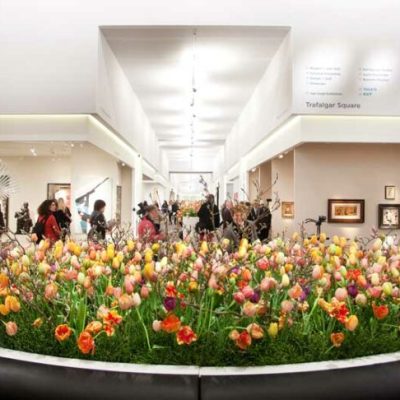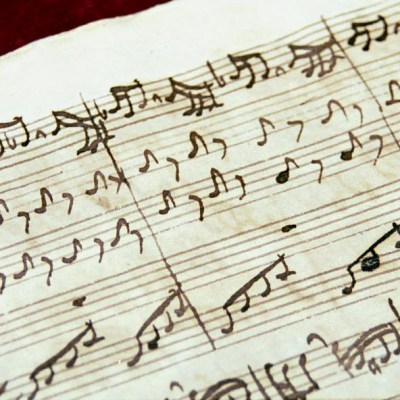From the March issue of Apollo: preview and subscribe here
The Van Gogh Museum in Amsterdam is an enterprising institution that combines popular appeal with groundbreaking research. Its director Axel Rüger talks to Apollo about drawing in the crowds and confounding their expectations
‘Van Gogh dies and is nobody,’ says Axel Rüger, ‘and 125 years later he is a global superstar.’ The director of the Van Gogh Museum is explaining why institutions across the Netherlands, Belgium and France have joined forces this year for Van Gogh 2015, a festival of events and exhibitions being staged under the banner of ‘125 years of inspiration’. But he might just as well be spelling out a conundrum that the Van Gogh Museum has faced since it opened in Amsterdam in 1973. Does the booming Van Gogh industry, that is, not blinker us to his artistry? ‘Our starting point is a rather unique one,’ Rüger deadpans: ‘We happen to be a single-artist museum on possibly the most famous artist on the planet.’
I meet Rüger at the museum’s offices, in a modern building a brisk 10-minute walk from the collection’s home on the north side of the Museumplein. What’s immediately striking here is the evidence of how determinedly the museum markets Van Gogh: walking into the bright atrium, I spot giant ‘Ear Chairs’ emblazoned with Wheatfield with Crows, what looks like a Sunflowers skateboard in a display case, and ‘Relievo’ versions of The Harvest, Almond Blossom and other works, three-dimensional prints that replicate the surface texture of Van Gogh’s paintings.
It would be easy to sneer at the Van Gogh Museum’s commercial endeavours, but to do so would mean misconstruing what makes it so dynamic. For a start, it caters to a young and predominantly international audience (the average visitor age is 32, ‘sort of ridiculously young’), whose expectations and attitudes are likely to differ from those of more traditional museum-going demographics. And although it is one of only four Dutch national museums, the institution generates around three quarters of its own revenues through ticket and merchandise sales, which, as Rüger points out, ‘gives you a different handle on your finances’, licensing a ‘nimble and inventive’ spirit that it might not have were it more dependent on state funding. For those of us in the United Kingdom used to a national museum culture of free admission, in which government grant-in-aid tends to be the most substantial income stream (still around 75 per cent of the National Gallery’s income in 2013–14, for instance), such a business-orientated outlook can sound surprising, even unpalatable. But might it not also be seen as instructive, particularly if aggressive cuts to public funding continue? If the Van Gogh Museum’s enterprising outlook is what sustains it, its director suggests, then it is also what fosters its independent ethos and ambitious programming.
The Van Gogh Museum seen from the Museumplein, with the Kisho Kurakawa exhibition wing on the left. Photo: René Gerritsen
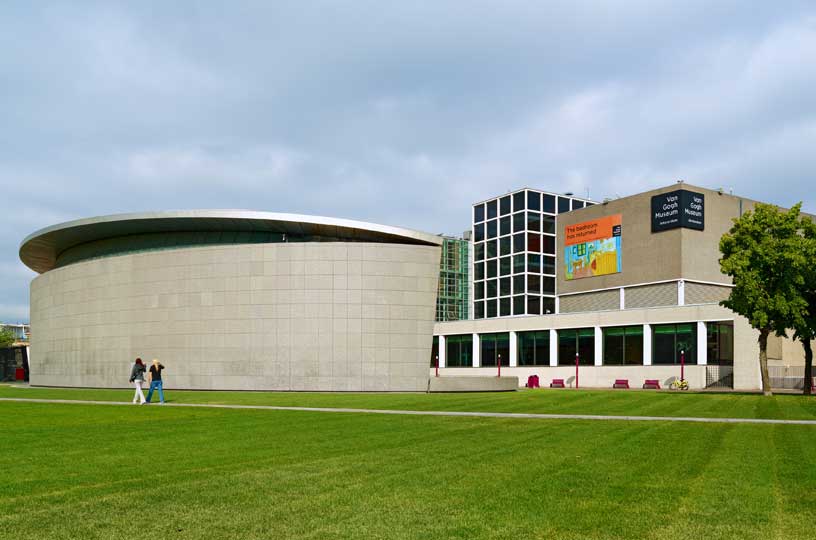
Rüger has been the director here since 2006, having previously been curator of Dutch paintings (1600–1800) at the National Gallery, where his achievements included co-curating ‘Vermeer and the Delft School’ (2001) with Michiel C. Plomp and the late Walter Liedtke. It was, he admits, quite a leap becoming the director here in his late 30s, but he had already made the decisive choice to move on from curating: ‘I was really lucky that I was on the first cohort of the Clore Leadership Programme,’ he says, ‘and when I came back from that I was quite clear I wouldn’t then be in my curatorial niche forever. I think I can honestly say that I took the decision to become a director with both eyes wide open.’ He is sanguine about having turned away from curating, and emphatic that the modern museum director must not be wistful in their role: ‘We have long passed the time of the gentleman director or curator director. The job of director is now a profession, not the extension of something you did before: you need leadership skills, financial skills, management skills, and to keep the bigger picture in mind.’
During Rüger’s tenure, as during that of his predecessor Sir John Leighton, the museum has been notably productive: its accomplishments in recent years include the culmination of the Van Gogh letters project in 2009 with the publication of the comprehensive edition of the artist’s correspondence following 15 years of research, and ‘Van Gogh at Work’, a groundbreaking exhibition on the painter’s materials and technique, likewise the fruit of a long-running research project. The Kisho Kurokawa exhibition wing, which opened in 1999 to the south of the main building by Gerrit Rietveld, is currently being adapted; from later this year it will also serve as the museum’s main entrance, solving current access problems and following the example of the Rijksmuseum and Stedelijk Museum in reorientating its buildings towards the open space of the Museumplein.
_DSC0737 Van Gogh’s works are interspersed with works by contemporaries, including, in the first floor galleries, Jules Dalou’s bronze, ‘Tall Peasant’ (1899). Photo: Van Gogh Museum
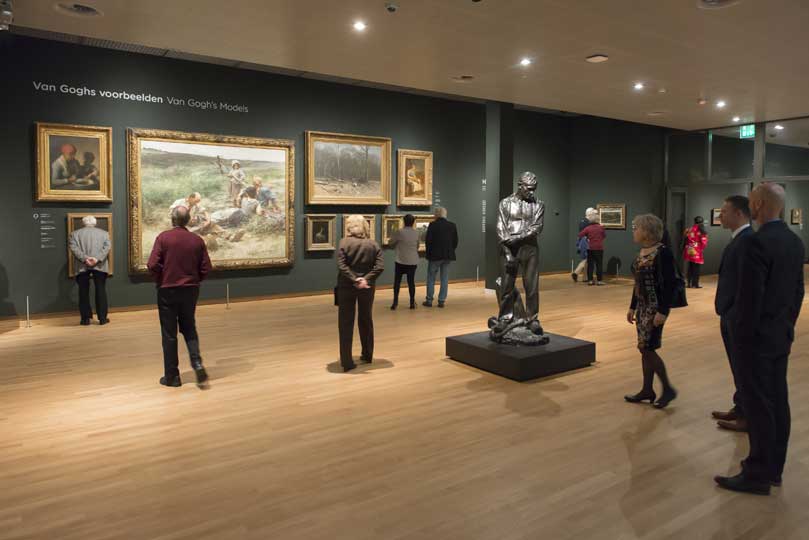
That said, there has long been a need to update the presentation of the collection. The museum closed for a seven-month renovation project in 2012–13, geared towards improving the sustainability and safety of the building; and although ‘Van Gogh at Work’ supplied the initial display when it reopened, this also threw into relief the need to find a more permanent solution. ‘It was a bit like that situation in your living room,’ says Rüger, ‘where you always think, I really should paint this room or get new furniture, and you never quite get around to it because there’s always a holiday or a new car that seems sexier.’
Only, one might add, this is a living room that houses more than 200 paintings by Vincent Van Gogh, as well as some 500 drawings and 800 letters, and the art collection that Vincent and his brother Theo assembled together – almost all on permanent loan from the Vincent Van Gogh Foundation. ‘We needed one consistent story throughout the building. All the Van Goghs used to be on the first floor so that the tourists could go “Vooooop!” and leave again. It was far too crowded. Now, if you really want to see Almond Blossom, I’m afraid you have to make it all the way up to the third floor.’ That notion of ‘one consistent story’ neatly encapsulates two principal goals of the recently unveiled redisplay: to recalibrate the relationship between the collection and building, and to take more account of the narrative that is Van Gogh’s life and legend. The latter is something that the museum has often preferred to overlook – but which many of its visitors are keenly invested in.
Both goals have been achieved with much intelligence and no little creativity, in a display that situates Van Gogh firmly in his time without losing sight of what sets him apart from it. The provocative mise-en-scène of the ground floor is a case in point. This presents a potted biography of Van Gogh through a series of his self-portraits, all of which are dwarfed by a vast blown-up detail along the length of an entire wall, showing the artist’s eyes from the Self-Portrait with Grey Felt Hat of 1887. What appears so familiar from a distance soon breaks up into a riot of brushstrokes, captured in such high resolution that even motes of dust are visible. It feels like both an invocation to look afresh at the paintings, and a reminder that we cannot but approach them via our preconceptions of the artist.
On the three floors that follow, the Van Gogh chronology plays out at a more leisurely tempo. One of the challenges that the museum’s curators have always faced is that the artist’s career spanned no more than a decade: an intense period of creativity from 1880–90 that used to be reflected in how his paintings were hung with such density on one floor of the museum. Thankfully, as Rüger says, ‘the works by Van Gogh now have a bit more breathing space’: the first-floor galleries display works from the period up to and including the painter’s notorious sojourn in Arles in 1889, while the third floor is dominated by the paintings he produced in the asylum at Saint-Rémy from May of that year, and in 1890 in Auvers-sur-Oise, where he spent the final months of his life, as well as offering a coda on his legacy. Meanwhile, the tricky spaces of the second-floor galleries (which have low ceilings and no natural light) draw on the museum’s recent research attainments to present further versions of Van Gogh: the avid correspondent; the working painter; and, with the introduction of a dedicated space for works on paper, the exploratory draughtsman.
Paintings from the museum’s rich holdings of 19th-century European art are now interspersed between groups of works by Van Gogh. They provide context and contrast, but are given breathing space of their own. In the early room dedicated to Van Gogh as ‘Painter of Peasant Life’, for instance, the centrepiece is that early masterpiece of coarse realism, The Potato Eaters (1885), while the adjacent walls carry, respectively, further earthy works from the Nuenen period (1884–85) and peasant scenes by the then-established Dutch artists Anthon van Rappard and Jozef Israëls. Meanwhile, showing Post-Impressionist works by Georges Seurat, Charles Angrand and others alongside paintings that Van Gogh executed in Paris from 1886–88 intimates how quickly the Dutchman appropriated the innovations of others and made them his own; while the pairing of In the Café: Agostina Segatori in Le Tambourin with Henri de Toulouse-Lautrec’s Young Woman at a Table, ‘Poudre de riz’ (both 1887) has a more thematic logic. Upstairs, crepuscular horizons by Charles-François Daubigny offer a framework for thinking about Van Gogh’s elongated late landscape paintings, without mitigating their strangeness.
What of the Van Gogh myth? Of the mad artist and his ear, and the still-disputed suicide? ‘The idea always used to be “you come in with a myth and leave with the art”’, says Rüger. ‘But Van Gogh’s personality, his life and tragedy, and the myth are so dominant that you cannot negate them. We decided it was time to give him a more prominent place as a person, and to dispel or at least address some of the myths.’ The artist’s illness, for instance, is now tackled on a panel shrewdly printed on the reverse of a partition that carries The Yellow House – pressing art and myth close, but also keeping them firmly apart.
The redisplay is a triumph for the museum’s curatorial team. But, adds Rüger, ‘from the word go, our education people were deeply involved with it’ – and not only them, one senses, but also IT, marketing and other departments, adding unobtrusive but noticeable grace-notes throughout the museum. There are for instance blow-ups where visitors can pause for photographs (which they can no longer do in front of the paintings), and touchscreens slotted discreetly into the circuit. There is a feeling of care here, perhaps a marker of how ‘the people who work here are extremely dedicated, extremely passionate about Van Gogh – it’s sort of a personal thing’. The staff and visitors mirror each other in this regard: ‘One of the future challenges,’ Rüger says, ‘is how we unlock what I always refer to as the emotional content around Van Gogh. If I had a dime for every story someone has already told me, I could retire.’
But the new display also tells of collaboration, reflecting a progressive structure behind the scenes. ‘It’s not for nothing that we’re in this office, which is all open plan,’ says Rüger. ‘We restructured our organisational model a few years ago, which is to say – and this is where I sometimes get people looking at me strangely, particularly from more traditional places – that we took a very concerted decision to create three units within the museum, for museum affairs, public affairs and administration, making it very clear that the three blocks are all of the same value to the organisation…American museums talk about the professional and the non-professional staff, which is something that I’ve always choked at.’ Although Van Gogh might seem incidental to this line of thought, the artist’s popularity is a decisive factor in carrying it off: ‘the curators lead in creating the programme, but someone also has to sell it…Of course, because of our dependence on visitor numbers, the necessity of doing that is probably more accepted in this organisation.’
And it is this type of thinking that makes the Van Gogh Museum such a modern institution: its willingness to engage its audience and their demands, its lack of nostalgia, and its confidence that museums can be organised along the lines of businesses without hindering core activities such as collection management and research. ‘Nowadays,’ as Rüger contests, ‘a modern, 21st-century cultural institution is as professional as any commercial organisation.’
Click here to buy the latest issue of Apollo.
Click here for more on the Van Gogh Museum.
Related Articles
Editor’s Letter: The single-artist museum (Thomas Marks)
Hollow memorials? the problem with artists’ houses (Martin Oldham)



